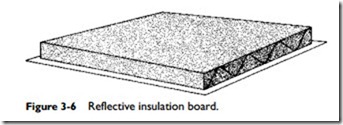Reflective Insulation
Reflective insulation (Figure 3-6) is designed to reflect heat rather than resist its rate of flow. This characteristic distinguishes it from other insulating materials. Reflective insulation is available in the form of foil-faced paper, foil-faced cardboard, foil-faced polyethylene bubbles, and foil-faced plastic film. Aluminum foil or a special
coating is commonly used as the facing (reflective surface). It is commonly used to insulate unfinished ceilings, walls, and floors in existing structures.
Air spaces must be provided on either side of a layer of reflective insulation. This type of insulating material has proven to be a good moisture barrier and exhibits a high degree of resistance to heat transmission.
Note
Reflective insulation is designed to reflect heat and not inter- fere with its flow. For that reason, its effectiveness is highest during the cooling season.
